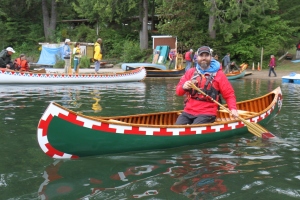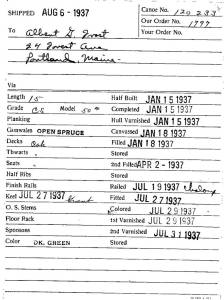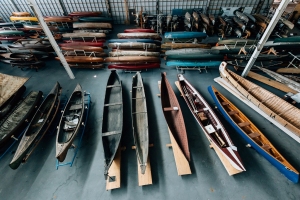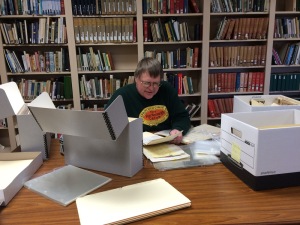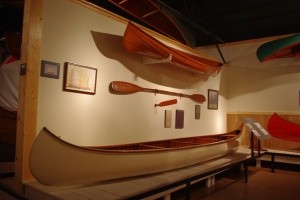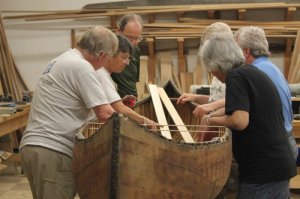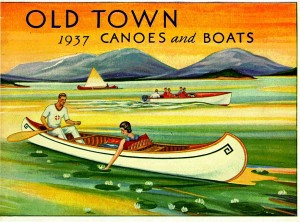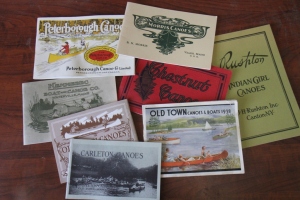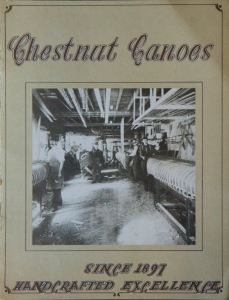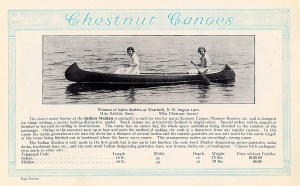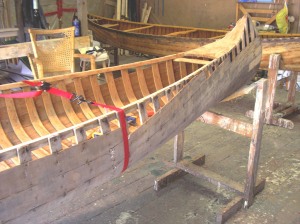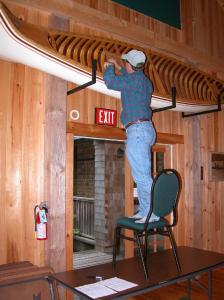How To Buy or Sell a Wood-Canvas Canoe
June 3, 2018
by Mike Elliott, Kettle River Canoes
email: artisan@canoeshop.ca
Frequently, I get an email from someone who is looking to sell their wood-canvas canoe. Typically, they tell me, “The canoe has been stored under-cover for the last twenty or thirty years and is in excellent shape. What would be a reasonable price to ask for my canoe?” Conversely, a person is considering the purchase of an old canoe and wants my opinion on whether or not the asking price is a reasonable one. In both cases, the best I can do is refer them to what I see on classified ads offering other wood-canvas canoes for sale.
I guess the simplest answer is: “It is worth whatever someone is willing to pay.” I have a hard time seeing these canoes as commodities. That is why I am in the business of repairing and restoring wood-canvas canoes. My clients tend to value their canoe based on a set of criteria far removed from monetary concerns. That said, wood-canvas canoes are bought and sold. Most of them are at least thirty years old and range in condition from pristine to ‘ready for the burn pile’. So, let’s look at the market and what tends to be ‘the going rate’.
Fully restored wood-canvas canoes tend to be listed in classified ads in a range from about $3,500 to $7,000. Bear in mind that a brand-new Old Town 16′ Guide canoe – made by hand on the original mould – currently sells for $9,000 USD (about $12,000 CAD). Serviceable canoes that need some work tend to be offered somewhere in the neighbourhood of $1,500 to $2,500. Canoes requiring a full restoration can be picked up for $50 to $500 (and sometimes you can get the canoe because you are willing to cart it away).
When people ask for my opinion on a specific canoe, I base my answer on what a professional canoe restoration shop would charge to bring it back to ‘like new’ condition. Almost any ‘original canoe in mint condition’ will require a new canvas. Unfortunately, the original canvas will only last about forty years (Oh, how I long for a return to the days before planned obsolescence). If the work is done by a professional canoe restorer, you are looking at spending about $2,000 to $3,000 after you have bought the canoe (all of these prices are in Canadian dollars). If the canoe ‘needs a little work’, be prepared to pay for a full restoration which could cost in the range of $3,500 to $5,500. And if it is a ‘basket-case’, the bill could far exceed what you would get for it if you ever decided to sell it (not unlike the cost of renovating an old house). So, when you see a fully restored canoe listed in a classified ad for $4,500, they are probably just trying to recoup the cost of the restoration.
About fourteen years ago, I bought an original Greenwood Canoe for $900. The bulk of the woodwork was in excellent condition and the interior varnish was still in very good condition. The canvas was original (about forty years old) and although it was not rotting, it needed to be replaced. Greenwood canoes are well-known to wood-canvas canoe enthusiasts in British Columbia. Bill Greenwood built canoes in Richmond, BC from the mid 1930’s to 1975. His workmanship was unequalled not to mention all of the Philippine mahogany (luan) used in components such as gunwales, decks and thwarts. Anyone who knows these canoes bows their head in reverence whenever they speak of Bill Greenwood and his canoes.
In my shop, I brought the canoe back to life. The original mahogany outwales were shot, so I replaced them with exact copies. I added a couple of coats of varnish to the woodwork and painted the new canvas the dark green that was typical for Greenwood canoes.
The next spring, I replaced the original slat seats with mahogany-framed hand-woven cane seats in the style of Greenwood canoes. I removed the bow-quarter thwart, installed a mahogany carrying yoke and moved the stern-quarter thwart to a position halfway between the stern seat and the centre yoke. I had no intentions of selling this canoe and, at that time, I had not seen a restored canoe sell for more than $2,500. So, when anyone asked me how much I wanted for it, I told them, “The canoe is all yours for $4,500.” In 2008, someone fell in love with my canoe and handed me a check.
Two years ago, I finished restoring a 16′ Chestnut Prospector for myself. I replaced the original solid-wood slat seats with hand-woven cane seats replicating the Chestnut style of cane seats. I then painted the canvas the original light green colour and installed copies of the original Chestnut deck and hull decals. These days, I rarely see a fully restored canoe selling for more than $4,000. If anyone asks me what I want for it, I will say, “$8,000 — but it’s not for sale.”
If you are selling, it is possible to get the price you are looking for. Just be prepared to wait a long time for that ‘special someone’ to come along. If you are buying, be prepared to factor in the cost of a full restoration once you have purchased the canoe.
The entire canoe restoration process is described in my book – This Old Canoe: How To Restore Your Wood Canvas Canoe.
If you live in Canada, CLICK HERE to buy the book.
If you live in the USA, CLICK HERE to buy the book.
If you live in the UK, CLICK HERE to buy the book.
Si vous habitez en France, CLIQUEZ ICI acheter le livre.
